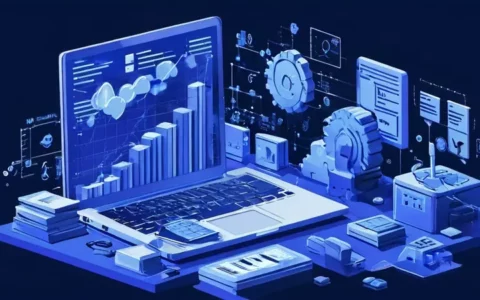
Programming Languages: Harnessing the Power of Computation
In the digital realm, programming languages serve as the foundational tools 1、enabling us to communicate with computers, 2、creating software applications, and 3、driving technological innovation. Enabling communication with computers is perhaps the most direct and vital role these languages play. Through precise instructions and syntax, they allow humans to translate complex ideas and processes into a form that machines can understand and execute. This capability lays the groundwork for the development of software, the operation of various electronic devices, and the advancement of computing technologies.
I. THE ESSENCE OF COMMUNICATION
At their core, programming languages bridge the gap between human thought and machine operation. By defining the logic and structure needed to perform tasks, they make it possible to execute everything from simple calculations to complex simulations. This interaction is not just about command execution; it’s about creating a dialog with machines, enabling them to act on specific inputs and deliver desired outcomes efficiently.
II. THE CREATION OF SOFTWARE APPLICATIONS
Beyond basic communication, programming languages are critical in developing software applications. These range from everyday mobile apps and desktop software to operating systems and large-scale database systems. The diversity of languages available—each with its own syntax, semantics, and use cases—allows developers to select the most suitable one for the task at hand, whether it needs to prioritize speed, ease of use, flexibility, or reliability.
III. INNOVATION AND TECHNOLOGY DEVELOPMENT
Programming languages are not static; they evolve and adapt, driving and responding to technological innovation. This dynamic relationship ensures that as new computational challenges and opportunities arise, language features and capabilities advance to meet these needs. This ongoing development is key to solving complex problems, enhancing computational efficiency, and paving the way for future technologies.
IV. SPECIALIZED APPLICATIONS AND DOMAINS
Certain programming languages are designed with specific applications in mind, enabling specialized tasks to be performed more effectively. From data analysis and artificial intelligence to web development and system programming, the choice of language can significantly impact the effectiveness and efficiency of the projects.
V. EDUCATION AND ACCESSIBILITY
Finally, programming languages play a crucial role in the field of education, offering a gateway for individuals to understand and engage with technology. Their varied levels of abstraction and complexity mean that there is an entry point for learners at different stages, facilitating skill development and opening up career opportunities in the tech industry.
In summary, programming languages are indispensable in the digital age, serving as the primary means of interacting with computers, creating diverse software solutions, and driving forward technological progress. Through their development and application, they enable the realization of ideas into concrete technologies that shape our world.
相关问答FAQs:
Q: What is the purpose of programming languages?
A: Programming languages are used to communicate instructions to a computer. They provide a set of rules and syntax that allows developers to write code and create software applications, websites, and other digital products. Programming languages enable humans to interact with machines and perform various tasks, such as data manipulation, calculations, automation, and problem-solving. They serve as a bridge between human logic and machine execution, facilitating the development of complex and powerful software systems. Programming languages are essential tools for programmers and software engineers in the modern digital age.
Q: How do programming languages work?
A: Programming languages work by translating human-readable instructions into machine-readable code. When a programmer writes code using a specific programming language, it goes through a process called compilation or interpretation. During compilation, the program is converted into machine code, which consists of a series of binary instructions that the computer can understand and execute. In interpretation, the code is executed line by line in real-time by an interpreter.
Different programming languages have different syntax rules and features, so they may vary in terms of readability, ease of use, and performance. Some languages are low-level and closer to machine code, while others are high-level and more focused on human readability and ease of development. Examples of popular programming languages include Python, JavaScript, Java, C++, and Ruby.
Q: Are there different types of programming languages?
A: Yes, there are different types of programming languages, each with its own purpose and application domain. Some common types include:
-
General-purpose languages: Designed to be versatile and suitable for a wide range of applications. Examples include Python, Java, and C++.
-
Web development languages: Specifically used for creating websites and web applications. These languages include HTML, CSS, JavaScript, and PHP.
-
Scripting languages: Lightweight languages primarily used for automating tasks or writing small scripts. Examples include Python, Ruby, and Perl.
-
Functional programming languages: Emphasize immutable data and pure functions. Examples include Haskell, Lisp, and Erlang.
-
Object-oriented programming (OOP) languages: Focus on organizing code into objects and classes. Popular OOP languages include Java, C++, and Python.
-
Database query languages: Specifically designed for interacting with databases and executing queries. Common examples are SQL and NoSQL languages like MySQL, PostgreSQL, and MongoDB Query Language.
These are just a few examples, and there are many more programming languages with unique features and purposes. The choice of language depends on the specific requirements of the project and the preferences of the developers.
文章标题:编程语言做什么用英文,发布者:不及物动词,转载请注明出处:https://worktile.com/kb/p/1617138

 微信扫一扫
微信扫一扫  支付宝扫一扫
支付宝扫一扫 



